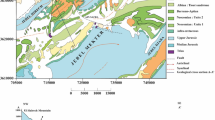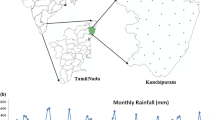Abstract
Groundwater survey has been carried out in the area of Gummanampadu sub-basin located in Guntur District, Andhra Pradesh, India for assessing the factors that are responsible for changing of groundwater chemistry and consequent deterioration of groundwater quality, where the groundwater is a prime source for drinking and irrigation due to non-availability of surface water in time. The area is underlain by the Archaean Gneissic Complex, over which the Proterozoic Cumbhum rocks occur. The results of the plotting of Ca2+ + Mg2+ versus HCO3 − + CO3 2−, Ca2+ + Mg2+ versus total cations, Na+ + K+ versus total cations, Cl− + SO4 2− versus Na+ + K+, Na+ versus Cl−, Na+ versus HCO3 − + CO3 2−, Na+ versus Ca2+ and Na+: Cl− versus EC indicate that the rock–water interaction under alkaline condition is the main mechanism in activating mineral dissociation and dissolution, causing the release of Ca2+, Mg2+, Na+, K+, HCO3 −, CO3 2−, SO4 2− and F− ions into the groundwater. The ionic relations also suggest that the higher concentrations of Na+ and Cl− ions are the results of ion exchange and evaporation. The influences of anthropogenic sources are the other cause for increasing of Mg2+, Na+, Cl−, SO4 2− and NO3 − ions. Further, the excess alkaline condition in water accelerates more effective dissolution of F−-bearing minerals. Moreover, the chemical data plotted in the Piper’s, Gibbs’s and Langelier–Ludwig’s diagrams, computed for the chloro-alkaline and saturation indices, and analyzed in the principal component analysis, support the above hypothesis. The groundwater quality is, thus, characterized by Na+ > Ca2+ > Mg2+ > K+: HCO3 − + CO3 2− > Cl− > SO4 2− > NO3 − > F− facies. On the other hand, majority of groundwater samples are not suitable for drinking with reference to the concentrations of TDS, TH, Mg2+ and F−, while those are not good for irrigation with respect to USSL’s and Wilcox’s diagrams, residual sodium carbonate, and magnesium hazard, but they are safe for irrigation with respect to permeability index. Thus, the study recommends suitable management measures to improve health conditions as well as to increase agricultural output.


















Similar content being viewed by others
References
APHA (1992) Standard methods for the examination of water and wastewater. American Public Health Association, Washington, DC
Aravindan S, Manivel M, Chandrasekhar SVN (2004) Groundwater quality in the hard rock area of the Gadilam river Basin, Tamil Nadu. J Geol Soc India 63:625–635
Berner EK, Berner RA (1987) The global water cycle, geochemistry and environment. Prentice-Hall, New Jersey
BIS (2003) Drinking water specifications. Bureau of Indian Standards, IS 10500
Bouwer H (1978) Groundwater hydrology. McGraw-Hill Book Company, New York
Central Ground Water Board (2006) Hydrogeological frame work and development prospects of Guntur District, Andhra Pradesh. Tech Report AAP 2003-3004, Southern Region, Hyderabad
Chow VT (1964) Handbook of applied hydrology. McGraw-Hill, New York
Cushing EM, Kantrowitz IH, Taylor KR (1973) Water resources of the Delmarva Peninsular. U. S. Geological Survey Professional Paper 822, Washington DC
Datta PS, Tyagi SK (1996) Major ion chemistry of groundwater in Delhi area: chemical weathering processes and groundwater flow regime. J Geol Soc India 47:179–188
Dar MA, Sankar K, Dar IA (2011) Major ion chemistry and hydrochemical studies of groundwater of parts of Palar river basin, Tamil Nadu, India. Environ Monit Assess 176:621–636
Davis JC (1986) Statistics and data analysis in geology. Wiley, New York
Domenico PA, Schwartz FW (1990) Physical and chemical hydrogeology. Wiley, New York
Doneen LD (1964) Notes on water quality in agriculture. Water Science and Engineering Paper 4001, California, Department of Water Sciences and Engineering, University of California
Earth Summit (1992) Programme of action for sustainable development (174–175). Agenda 21, UNCED, Rio de Janeiro, Brazil
Fetter CW (1990) Applied hydrogeology. CBS Publishers and Distributors, New Delhi
Freeze RA, Cherry JA (1979) Groundwater. Prentice-Hall, New Jersey
Garg VK, Suthar S, Singh S, Sheoran A, Meenakshi Garima, Jai S (2009) Drinking water quality in villages of southwestern Haryana, India: assessing human health risks associated with hydrochemistry. Env Geol 58:1329–1340
Garrels RM, Christ CL (1965) Solutions, minerals and equilibria. Harper and Row, New York
Gibbs RJ (1970) Mechanism controlling world’s water chemistry. Science 170:1088–1090
Giridharan L, Venugopal T, Jayaprakash M (2010) Identification and evaluation of hydrogeochemical processes on river Cooum, South India. Environ Monit Assess 162:277–289
Gowd SS (2005) Assessment of groundwater quality for drinking and irrigation purposes: a case study of Peddavanka watershed, Anantapur District, Andhra Pradesh, India. Env Geol 48:702–712
Hem JD (1991) Study and interpretation of the chemical characteristics of natural water: USGS Professional Paper Book 2254. Scientific Publishers, Jodhpur
Holden WS (1970) Water treatment and examination. J & Churchill Publishers, London
ISI (1963) Indian standard methods of sampling and tests (physical and chemical) for water used in industry. Indian Standard Institute, India
Jacks G (1973) Chemistry of groundwater in a district in southern India. J Hydrol 18:185–200
Jacks G, Bhattacharya P, Chaudhary V, Singh KP (2005) Controls on the genesis of some high-fluoride groundwaters in India. Appl Geochem 20:221–228
Jankowski J, Acworth RL (1997) Impact of debris-flow deposits on hydrogeochemical processes and the development of dry land salinity in the Yass River catchment, New South Wales, Australia. Hydrogeol J 5:71–88
Jeevanandam M, Kannan R, Srinivasalu S, Rammohan V (2006) Hydrogeochemistry and groundwater quality assessment of lower part of the Ponnaiyar River Basin, Cuddalore District, South India. Environ Monit Assess 132:263–274
John Devadas D, Subba Rao N, Thirupathi Rao B, Srinivasa Rao KV, Subrahmanyam A (2007) Hydrogeochemistry of the Sarada river basin, Visakhapatnam district, Andhra Pradesh, India. Env Geol 52:1331–1342
Kaiser HF (1958) The varimax criterion for analytic rotation in factor analysis. Psychometrika 23:187–200
Karanth KR (1997) Groundwater assessment, development and management. Tara McGraw-Hill Publ. Co. Ltd, New Delhi
Khurshid S, Zaheerudin (2004) Geochemistry of groundwater: an overview of sporadic fluoride and nitrate contamination in parts of Yamuna basin. J Appl Geochem 6:25–35
Krishna Kumar S, Rammohan V, Dajkumar Sahayam J, Jeevanandam M (2009) Assessment of groundwater quality and hydrogeochemistry of Manimuktha River Basin, Tamil Nadu, India. Environ Monit Assess 159:341–351
Langelier WF, Ludwig HF (1942) Graphic method for indicating the mineral character of natural water. J Am Water Works Assoc 34:335–352
Mandal P, Upadhyay R, Hasan A (2010) Seasonal and spatial variation of Yamuna River water quality in Delhi, India. Environ Monit Assess 170:661–670
McCarthy MF (2004) Should we restrict chloride rather than sodium? Med Hypothesis 63:138–148
Meyback M (1987) Global chemical weathering of surficial rocks estimated from river dissolved loads. Am J Sci 287:401–428
Naik PK, Awasthi AK, Anand AVSS, Behera PN (2009) Hydrogeochemistry of the Koyna River basin, India. Environ Earth Sci 59:613–629
Pandian K, Sankar K (2007) Hydrogeochemistry and groundwater quality in the Vaippar River Basin, Tamil Nadu. J Geol Soc India 69:970–982
Piper AM (1944) A graphic procedure in the geochemical interpretation of water analyses. Am Geophys Union Trans 25:914–923
Purushotham D, Prakash MR, Narsing Rao A (2011) Groundwater depletion and quality deterioration due to environmental impacts in Maheshwaram watershed of R.R. district, AP (India). Environ Earth Sci 62:1707–1721
Rajmohan N, Elango L (2006) Hydrogeochemistry and its relation to groundwater level fluctuation in the Palar and Cheyyar river basins, Southern India. Hydrol Process 20:2415–2427
Raju NJ (2007) Hydrogeochemical parameters for assessment of groundwater quality in the Upper Gunjanaeru River Basin, Cuddapah District, Andhra Pradesh, South India. Env Geol 52:1067–1074
Raju NJ (2009) Groundwater quality in the Lower Varuna River Basin, Varanasi District, Uttar Pradesh. J Geol Soc India 73:178–192
Rashid U, Izrar A (2007) Hydrochemical characteristics of groundwater in parts of Kushva-Yamuna basin, Muzaffarnagar district, UP. J Geol Soc India 69:970–982
Ravi Kumar S (2010) Groundwater conditions in Gummandmpadu sub-basin, Bollapalli Mandal, Guntur District, Andhra Pradesh. M.Phil dissertation submitted to Acharya Nagarjuna University, Nagarjunanagar, Guntur District, Andhra Pradesh, India
Ravikumar P, Somashekar RK, Mhasizonuo A (2011) Hydrochemistry and evaluation of groundwater suitability for irrigation and drinking purposes in the Markandeya River basin, Belgaum District, Karnataka State, India. Environ Monit Assess 173:459–487
Richards LA (1954) Diagnosis and Improvement of Saline and Alkalis Soils. US Department of Agriculture Handbook 60, 160 p
Ritzi RW, Wright SL, Mann B, Chen M (1993) Analysis of temporal variability in hydrogeochemical data used for multivariate analyses. Ground Water 31:221–229
Rogers RJ (1989) Geochemical comparison of groundwater in areas of New England, New York and Pennsylvania. Ground Water 27:690–712
Sarin MM, Krishnaswamy S, Dillikumar, Somayajulu BLK, Moore WS (1989) Major-ion chemistry of the Ganga–Brahmaputra river system: weathering processes and fluxes to the Bay of Bengal. Geochim Cosmochim Acta 53:997–1009
Sawyer CN, McCarty PL (1967) Chemistry for sanitary engineers, 2nd edn. McGraw-Hill, New York
Schoeller H (1965) Qualitative evaluation of groundwater resources. In: Methods and Techniques of groundwater investigation and development. Water Research Series, vol 33. UNESCO, Paris
Schoeller H (1967) Geochemistry of groundwater. In: An international guide for research and practice. UNESCO, Paris, Ch. 15, pp 1–18
Shankar K, Aravindan S, Rajendran S (2011) Hydrogeochemistry of the Paravanar River Sub-Basin, Cuddalore District, Tamilnadu, India. E-J Chem 8:835–845
Sreedevi PD (2004) Groundwater quality of Pageru river basin, Cuddapah district, Andhra Pradesh. J Geol Soc India 64:619–636
Stallard RE, Edmond JM (1983) Geochemistry of Amazon River: the influence of the geology and weathering environment on the dissolved load. J Geophys Res 88:9671–9688
Stumm W, Morgan JJ (1996) Aquatic chemistry. Wiley-Interscience, New York
Subba Rao N (2006) Seasonal variation of groundwater quality in a part of Guntur District, Andhra Pradesh, India. Env Geol 49:413–429
Subba Rao N (2008) Factors controlling the salinity in groundwaters from a part of Guntur district, Andhra Pradesh, India. Environ Monit Assess 138:327–341
Subba Rao N (2011) High-fluoride groundwater. Environ Monit Assess 176:637–645
Subba Rao N, Surya Rao P (2010) Major ion chemistry of groundwater in a river basin: a study from India. Environ Earth Sci 61:757–775
Subba Rao N, Surya Rao P, Venktram Reddy G, Nagamani M, Vidyasagar G, Satyanarayana NLVV (2011) Chemical characteristics of groundwater and assessment of groundwater quality in Varaha River Basin, Visakhapatnam District, Andhra Pradesh, India. Environ Monit Assess. doi:10.1007/s10661-011-2333-y
Subramani T, Elango L, Damodarasamy SR (2005) Groundwater quality and its suitability for drinking and agricultural use in Chithar River Basin, Tamil Nadu, India. Env Geol 47:1099–1110
Szaboles I, Darab C (1964) The influence of irrigation water of high sodium carbonate content of soils. In: Proceedings of 8th international congress of ISSS, Trans, II, pp 803–812
Todd DK (1980) Groundwater hydrology. Wiley, New York
Umar R, Absar A (2003) Chemical characteristics of groundwater in parts of the Gambhir River Basin, Bharatpur District, Rajasthan, India. Env Geol 44:535–544
Umar R, Ahmed I (2007) Hydrochemical characteristics of groundwater in parts of Krishni-Yamuna Basin, Muzaffarnagar district, U.P. J Geol Soc India 69:989–995
Venugopal T, Giridharan L, Jayaprakash M, Periakali P (2009) Environmental impact assessment and seasonal variation study of the groundwater in the vicinity of River Adyar, Chennai, India. Environ Monit Assess 149:81–97
Walton WC (1970) Groundwater resource evaluation. McGraw-Hill, New York
WHO (2004) Guidelines for drinking water quality. World Health Organization, Geneva
WHO (2011) Guidelines for drinking water quality. World Health Organization, Geneva
Wilcox LV (1955) Classification and use of irrigation water. U.S. Department of Agriculture Circular 969, Washington, DC
Acknowledgments
The author, A. Subrahmanyam, thanks the University Grants Commission, New Delhi, for financial assistance to carry out this work under a research project. The authors are very much thankful to the anonymous reviewers for their valuable suggestions to improve the manuscript.
Author information
Authors and Affiliations
Corresponding author
Rights and permissions
About this article
Cite this article
Subba Rao, N., Subrahmanyam, A., Ravi Kumar, S. et al. Geochemistry and quality of groundwater of Gummanampadu sub-basin, Guntur District, Andhra Pradesh, India. Environ Earth Sci 67, 1451–1471 (2012). https://doi.org/10.1007/s12665-012-1590-6
Received:
Accepted:
Published:
Issue Date:
DOI: https://doi.org/10.1007/s12665-012-1590-6




